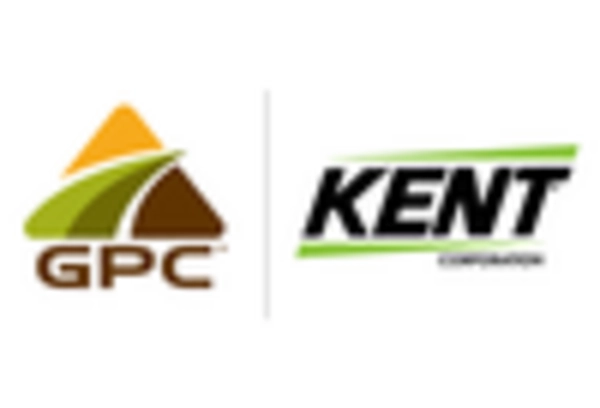Growth of Bioplastics Sector
The corn starch market is significantly influenced by the burgeoning bioplastics sector. As environmental concerns rise, there is a marked shift towards biodegradable materials, with corn starch serving as a key raw material for bioplastics. In 2025, the bioplastics market is projected to grow at a CAGR of 15%, with corn starch-based products gaining traction due to their eco-friendly attributes. This growth is likely to attract investments in research and development, fostering innovation in bioplastic applications. Consequently, the corn starch market is poised to expand as manufacturers seek sustainable alternatives to traditional plastics, aligning with consumer preferences for environmentally responsible products.
Rising Demand in Food Industry
The corn starch market experiences a notable surge in demand driven by the food industry. As consumers increasingly seek convenience foods, the utilization of corn starch as a thickening agent and stabilizer becomes more prevalent. In 2025, the food sector accounts for approximately 70% of the total corn starch consumption in the US. This trend is likely to continue as manufacturers innovate with new formulations that enhance texture and shelf life. Additionally, the growing popularity of gluten-free products further propels the demand for corn starch, as it serves as a suitable alternative for wheat-based ingredients. The corn starch market is thus positioned to benefit from these evolving consumer preferences, indicating a robust growth trajectory in the coming years.
Technological Advancements in Production
Technological advancements play a crucial role in shaping the corn starch market. Innovations in processing techniques, such as enzymatic hydrolysis and dry milling, enhance the efficiency and yield of corn starch production. These advancements not only reduce production costs but also improve the quality of the final product. In 2025, the market witnesses a shift towards more automated processes, which increases output while minimizing waste. Furthermore, the integration of data analytics and IoT in production facilities allows for better monitoring and optimization of operations. As a result, manufacturers are likely to achieve higher profit margins, thereby stimulating further investment in the corn starch market.
Increased Use in Pharmaceutical Applications
The corn starch market sees a growing application in the pharmaceutical sector, where it is utilized as a binder and disintegrant in tablet formulations. The demand for corn starch in pharmaceuticals is expected to rise as the industry focuses on developing more efficient drug delivery systems. In 2025, the pharmaceutical segment accounts for approximately 15% of the total corn starch consumption in the US. This trend is likely to be driven by the increasing prevalence of chronic diseases and the need for effective medication. As pharmaceutical companies continue to explore innovative formulations, the corn starch market is positioned to benefit from this expanding application, indicating a promising outlook.
Regulatory Support for Agricultural Practices
Regulatory support for sustainable agricultural practices is emerging as a significant driver for the corn starch market. The US government promotes initiatives aimed at enhancing crop yields and reducing environmental impact, which directly benefits corn production. In 2025, policies encouraging the use of precision agriculture and sustainable farming techniques are likely to lead to increased corn supply, thereby supporting the corn starch market. Additionally, these regulations may incentivize farmers to adopt practices that enhance soil health and reduce chemical inputs. As a result, the corn starch market is expected to thrive, bolstered by a stable and sustainable supply chain.

















Leave a Comment